DETAILS
Keeping the Peace: Early Policing in North-Central Alberta
Runs until Sunday, April 26
Musée Héritage Museum
Call 780-459-1528 or visit museeheritage.ca for more information.
Things sure have changed in law enforcement over the years, decades and even the centuries. For one thing, it’s easier to police the people when there are laws in the first place.
Take the buffalo hunt, for instance. Two centuries ago, these community events were not small affairs as they often had more than 1,000 in attendance for the hunting party. That (along with all the guns, dogs and heightened activity, especially with guns) meant rules were needed. Order was needed. Laws were needed.
This, according to the new exhibit at the Musée Héritage Museum, led to the creation of what were called the Laws of the Prairies, better known as the Laws of the Buffalo Hunt, which the Métis used to manage large groups of people from different communities, and looks at how the arrival of policing bodies from settler communities affected the people of the region.
“They created these eight rules. They elected a president and captains and divvied up the control and peacekeeping, and just organization,” explained curator Joanne White, while walking through Keeping the Peace. “Quite a chore.”
It’s tough to imagine those challenges, but the exhibit does help.
Produced in partnership with the Fort Heritage Precinct, the exhibit offers a look at the early days of policing in and around St. Albert, Edmonton and Fort Saskatchewan, and how things evolved from the creation of the North-West Mounted Police, the Alberta Provincial Police, and the Royal Canadian Mounted Police.
For some people, this might be the first time that they learn that Alberta had at one time its own police force.
The Alberta Provincial Police was formed in 1917 after the RCMP had pulled back from serving the West, partly because of the First World War, White continued. There was, at least in St. Albert, a period without any local police. Town police services were inconsistent throughout most of the 1920s as well,
When the Alberta Provincial Police were formed in 1917, St. Albert had a period without local police. Throughout the 1920s town police services were sporadic. Vital Michelot took the job of town policeman around 1927, serving until the RCMP returned in 1944. He was the last town policeman, earning $15/month at one point, leaving him to find other supplementary ways of making ends meet.
Better than a badge
Keeping the Peace first focuses on Indigenous peacekeeping when the best methods of regulating people’s behaviours involved words, as exemplified by the first ones on the wall right at the entrance:
"We don't have a word for crime. Our word is mistake.” – Judge Eugene Creighton, Blood Tribe.
“We also talk about how storytelling was how they conveyed right and wrong in various communities,” White continued.
Storytelling is at the heart of Indigenous culture, the exhibit’s text notes, as it is how history and tradition are preserved and passed on through the generations. It is through storytelling that cultural values are expressed, laying out the expectations for, and consequences of, one’s behaviour.
Listening is also an integral part of the process.
“There is no concept of justice in Cree culture. The nearest word is kintohpatatin, which loosely translates to ‘you've been listened to.’ But kintohpatatin is richer than justice – really it means you've been listened to by someone compassionate and fair, and your needs will be taken seriously,” the text continues with a quote by Chief Edmund Metatawabin from Up Ghost River: A Chief's Journey Through the Turbulent Waters of Native History.
Responsibility and reparation are the key tenets of that justice system. Its goal is to bring balance back to the community through the emotional, physical, mental, and spiritual restoration of the whole persons involved, meaning both the wrongdoer and whomever they have wronged.
No exhibit without cool old artifacts
The modern red serge of the RCMP is a striking uniform, but check out the helmets and the buffalo coats and muskrat hats that were used in the past.
“We are excited to present this exhibition. We brought together compelling items that truly tell the stories reflecting the evolution of policing in our region,” White stated.
Along with other pieces of equipment, the display will also feature “a case full of badges” and jailkeys, one set of which came from a member of the public who found them in a very unlikely place.
“A guy found them on eBay ... they belonged to (Joe) Ouimet,” she said, referring to the town police officer at the turn of the century. “He bought them and just donated them. They just turned up and came back to the museum.”
With nearly 1,000 townsfolk needing a lawkeeper, Constable Ernest Seymour earned $40 a month to keep order and enforce the bylaws. Unfortunately, he only lasted two years before he lost his patience with town council who he reportedly called a pack of crooks. Joseph Ouimet replaced him and lasted longer, though eventually another officer was also hired, and they split the pay while the workload increased. The new constable, Mr. Guertin, helped maintain order by maintaining the sidewalks and roads, lighting the streetlamps, keeping the town hall in good shape, inspecting noxious weeds, and operating the town weigh scales.



